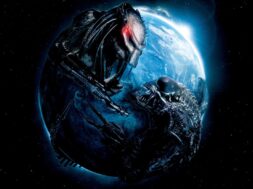This article contains heavy spoilers.
“When you see someone change, in front of you, and you know there’s no going back. Scares me to death.”
There’s a scene in the first act of The Beach House, now streaming through Shudder, where the film’s two couples, Emily (Liana Liberato) & Randall (Noah Le Gros) and Mitch (Jake Weber) & Jane (Maryann Nagel), are eating dinner together at the titular house on the beach. Emily, an organic chemistry student with her sights set on becoming a scientist, starts talking about astrobiology, particularly expressing her passion for life on this planet and the way “organisms can adapt to extreme environments.” She explains, “I’m in awe of it.” Mitch, in response to Emily’s passionate musing, offers up a simple “Over my head!” and the conversation changes to something else entirely. By the end of The Beach House, it’s likely that many viewers will be left with that very same thought in their own mind: “Over my head.” Jeffrey A. Brown‘s directorial debut is, after all, a movie that presents big ideas without going out of its way to express precisely what is actually happening at any given moment in time. It’s cosmic horror personified, keeping easy answers out of arm’s reach.
But what does it all mean? Let’s dive into the deep end together.
In the film, Emily & Randall, a young couple, arrive at the beach house to find that Mitch & Jane, friends of Randall’s parents, are also staying at the vacation home for the weekend. What they don’t know is that *something* has escaped from the ocean floor beneath their feet, a sort of aquatic horror-style ticking time bomb that we know is going to explode at any minute. And, of course, it does. After a night of wine-drinking and marijuana consumption that gets suitably trippy even before any of the true cosmic horrors are introduced, that *something* from the bottom of the ocean comes knocking, infecting everything in its path.
What is that *something*? Well, one thing it’s definitely *not* is a full-on Lovecraftian monster like the ones you’ll find in this year’s aquatic horror films Underwater and Sea Fever. Rather, it’s a sort of thick fog that seems to turn infected human hosts into almost zombie-like creatures, crawling on the ground with their eyes completely whited out. Human still, but not quite human all the same. That fog also brings along with it a host of slimy little aquatic terrors, one of which gets embedded in the bottom of Emily’s foot in what is unquestionably the downright hardest-to-watch moment in the entire movie.
But The Beach House isn’t quite a monster movie, even if we do catch a brief glimpse of a gnarly basement monster in the final act. Rather, it’s almost more eco-horror than it is aquatic horror, ambitiously and quite literally documenting the end of human life on Planet Earth and the chaotic beginnings of a whole new lifeform. When Emily was talking about organisms adapting to extreme environments at the start of the film, that wasn’t just throwaway dialogue to help establish that she’s the scientific type. Rather, that was writer/director Brown plainly laying out the surprising climax of the movie – and it’s not the only time the film’s dialogue tips its hat to what is really going on out there in the thick, creature-filled fog.
Another particularly important dialogue exchange takes place shortly after the dinner, and after the edibles have been consumed. Emily further fleshes out some of her beliefs and interests in a conversation with Jane, again commenting on the origins of life on Earth. Jane asks her what Earth would have looked like at the earliest stages of the planet, and Emily replies: “Swirling gases. Unstable. Boiling. Chaos.” At the time, since we have no idea where the movie is headed at this point, it seems to be little more than a throwaway conversation between two characters who are very much high. But in hindsight, after all has been revealed and the end credits are rolling across the screen, it becomes clear that what Emily was describing was, unbeknownst to her, the very nightmare she was headed into.
Swirling gases. Unstable. CHAOS. This is the world of The Beach House, and we learn in the final act that it’s not confined to that island and that island alone. Rather, as we glean from two different radio conversations – not unlike the way George Romero used television news reports to build out a large scale zombie apocalypse on a small budget in Night of the Living Dead – whatever is happening is downright apocalyptic in scope. One radio news report indicates that microbes that had been preserved in rock at the bottom of the sea were freed by the Earth’s heat, bubbling up to the surface and infecting everything in their wake. The film, in fact, opens with this very imagery, ominously teasing the horrors exploding to the surface.
In the film’s final moments, it’s “final girl” Emily who finds herself infected by the eco-nightmare that has already consumed both Jane and Randall – Mitch, in a devastating moment, willingly gives his life to the sea as a means to escape his own personal fears and pains. Initially doing whatever she can to outrun the inevitable, Emily eventually gives in and walks herself back to the beach where the whole nightmare began. The final shots of The Beach House show us Emily laying on the sand, her eyes turning stark white – the tell-tale sign, in the film’s universe, that the infection has taken hold. But Emily, by this point in time, has clearly made peace with what’s coming next. “Don’t be scared,” she repeats to herself while she’s waiting for the inevitable. The water soon washes over Emily and just like that, she’s gone.
Unlike all the other characters who become infected throughout The Beach House, it would seem that scientist Emily is keenly aware of what’s going on – even if we, as viewers along for the Lovecraftian ride, may not be so sure. “Organisms can adapt to extreme environments,” Emily had explained over dinner at the start of the movie. “I’m in awe of it.” And in those final moments of the film, armed with the knowledge that she herself is adapting to a newly extreme environment, you get the sense that she may very well be in some degree of awe. Emily, who was working on getting her diver’s certification so she could “go on deep sea studies in some of the most inhospitable places on the planet,” eventually finds a horrifying bizarro version of that dream coming quite true. She’s got a front row seat to the origins of a new beginning for Earth, and her repeated mantra suggests acceptance rather than fear.
The death of one life form. The birth of something new entirely.
“Don’t be scared,” Emily tells us, as we ponder how cosmically terrifying her fate truly is.











